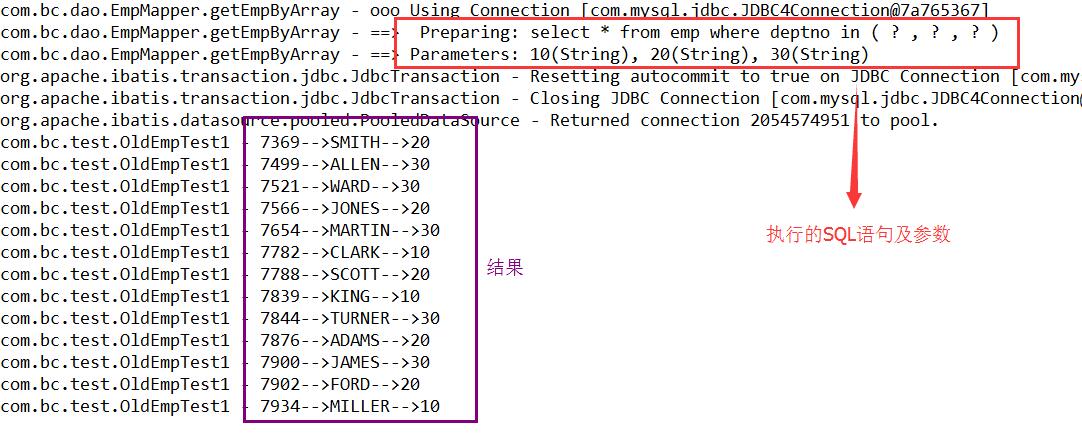MyBatis-動態SQL的if、choose、when、otherwise、trim、where、set、foreach使用
動態SQL是MyBatis最強大的特性之一。用於實現動態SQL的主要元素如下:
1、if
2、choose、when、otherwise
3、trim、where、set
4、foreach
程式碼示例:
1、if
EmpMapper.xml配置
<select id="getEmpByIf" resultType="Emp" parameterType="Emp">
select * from emp where 1 = 1
<if test="job != null and job != ''">
and job = #{job}
</if>
<if test="deptno != null ">
and deptno = #{deptno}
</if>
</select>測試程式碼
public void getEmpByIf() {
SqlSession sqlSession = null;
Emp emp = new Emp();
//工作為空字串
emp.setJob("");
//部門編號為10
emp.setDeptno(10);
List<Emp> empList = new ArrayList<>();
try {
sqlSession = MyBatisUtil.createSqlSession();
//EmpMapper介面中新增對應方法
empList = sqlSession.getMapper(EmpMapper.class).getEmpByIf(emp);
} catch (Exception e) {
e.printStackTrace();
} finally {
MyBatisUtil.closeSqlSession(sqlSession);
}
for (Emp emp1 : empList) {
logger.debug(emp1.getEmpno() + "-->" + emp1.getEname() + "-->" + emp1.getDeptno());
}
}輸出結果
從結果可以看出因為job為空字串所以條件沒拼接,輸出結果正確
2、choose、when、otherwise
類似於Java中的switch case default
EmpMapper.xml配置
<select id="getEmpByChoose" resultType="Emp" parameterType="Emp">
select * from emp where 1 = 1
<choose>
<when test="job != null">
and job = #{job}
</when>
<when test="deptno != null">
and deptno = #{deptno}
</when>
<otherwise>
and mgr = #{mgr}
</otherwise>
</choose>
</select>測試程式碼
public void getEmpByChoose() {
SqlSession sqlSession = null;
Emp emp = new Emp();
//工作為CLERK
emp.setJob("CLERK");
//部門編號為10
emp.setDeptno(10);
//經理為7698
emp.setMgr(7698);
List<Emp> empList = new ArrayList<>();
try {
sqlSession = MyBatisUtil.createSqlSession();
//EmpMapper介面新增對應方法
empList = sqlSession.getMapper(EmpMapper.class).getEmpByChoose(emp);
} catch (Exception e) {
e.printStackTrace();
} finally {
MyBatisUtil.closeSqlSession(sqlSession);
}
for (Emp emp1 : empList) {
logger.debug(emp1.getEmpno() + "-->" + emp1.getEname() + "-->" + emp1.getDeptno());
}
}執行結果
可以看出,只有一個條件生效,也就是隻執行滿足的條件when,沒有滿足的條件就執行otherwise,表示預設條件。
3、where
EmpMapper.xml配置
<select id="getEmpByWhere" resultType="Emp" parameterType="Emp">
select * from emp
<where>
<if test="job != null and job != ''">
and job = #{job}
</if>
<if test="deptno != null">
and deptno = #{deptno}
</if>
</where>
</select>測試程式碼
public void getEmpByWhere() {
SqlSession sqlSession = null;
Emp emp = new Emp();
//工作為CLERK
emp.setJob("CLERK");
//部門編號為10
emp.setDeptno(10);
List<Emp> empList = new ArrayList<>();
try {
sqlSession = MyBatisUtil.createSqlSession();
//EmpMapper介面中新增對應方法
empList = sqlSession.getMapper(EmpMapper.class).getEmpByWhere(emp);
} catch (Exception e) {
e.printStackTrace();
} finally {
MyBatisUtil.closeSqlSession(sqlSession);
}
for (Emp emp1 : empList) {
logger.debug(emp1.getEmpno() + "-->" + emp1.getEname() + "-->" + emp1.getDeptno());
}
}執行結果
從配置的SQL語句及結果來看,where能在第一次滿足新增條件時自動補全where這個單詞,而且如果有and會替換掉,如果滿足條件拼接的第二個語句沒有and,會報錯
4、set
EmpMapper.xml配置
<update id="updateEmpBySet" parameterType="Emp">
update emp
<set>
<if test="ename != null and ename != ''">
ename = #{ename},
</if>
<if test="job != null and job != ''">
job = #{job},
</if>
</set>
where empno = #{empno}
</update>測試程式碼
public void updateEmpBySet() {
SqlSession sqlSession = null;
//要更新的Emp物件
Emp emp = new Emp();
emp.setEmpno(2333);
emp.setEname("new name");
emp.setJob("new job");
try {
sqlSession = MyBatisUtil.createSqlSession();
sqlSession.getMapper(EmpMapper.class).updateEmpBySet(emp);
sqlSession.commit();
} catch (Exception e) {
e.printStackTrace();
sqlSession.rollback();
} finally {
MyBatisUtil.closeSqlSession(sqlSession);
}
}執行結果
可以看出,set會在成功拼接的條件前加上SET單詞且最後一個”,”號會被無視掉,但是有可能需要”,”的地方不能省略”,”否則異常。
5、trim
EmpMapper.xml配置
胡亂寫了一段程式碼用來測試(●ˇ∀ˇ●)
直接上結果。。。
o(^▽^)o可以看到成功匹配掉了開頭的$和末尾的*
6、foreach
foreach標籤用於遍歷生成單個或多個資料,根據傳入的引數型別有倆種配置方式
1、引數為陣列
EmpMapper介面新增方法
public List<Emp> getEmpByArray(String[] deptnos);測試程式碼
public void getEmpByArray() {
SqlSession sqlSession = null;
List<Emp> empList = new ArrayList<>();
//引數為陣列
String[] deptnos = {"10", "20", "30"};
try {
sqlSession = MyBatisUtil.createSqlSession();
empList = sqlSession.getMapper(EmpMapper.class).getEmpByArray(deptnos);
} catch (Exception e) {
e.printStackTrace();
} finally {
MyBatisUtil.closeSqlSession(sqlSession);
}
for (Emp emp : empList) {
logger.debug(emp.getEmpno() + "-->" + emp.getEname() + "-->" + emp.getDeptno());
}
}結果
2、引數為List集合
EmpMapper介面新增方法
public List<Emp> getEmpByList(List<String> deptnos);測試程式碼
public void getEmpByList() {
SqlSession sqlSession = null;
List<Emp> empList = new ArrayList<>();
//引數為集合
List<String> list = new ArrayList<>();
list.add("10");
try {
sqlSession = MyBatisUtil.createSqlSession();
empList = sqlSession.getMapper(EmpMapper.class).getEmpByList(list);
} catch (Exception e) {
e.printStackTrace();
} finally {
MyBatisUtil.closeSqlSession(sqlSession);
}
for (Emp emp : empList) {
logger.debug(emp.getEmpno() + "-->" + emp.getEname() + "-->" + emp.getDeptno());
}
}結果
相關文章
- MyBatis系列(七):MyBatis動態Sql之choose,where,set標籤的用法MyBatisSQL
- MyBatis從入門到精通(七):MyBatis動態Sql之choose,where,set標籤的用法MyBatisSQL
- mybatis的 choose -- when test -- otherwise 標籤和 if test 標籤的區別MyBatis
- ORACLE SQL開發where子句之case-whenOracleSQL
- Mybatis where 1=1 動態sql問題MyBatisSQL
- SQL中的CASE WHEN使用SQL
- MyBatis引數傳入集合之foreach動態sqlMyBatisSQL
- powershell中的where和foreach比較
- SQL Case when 的使用方法SQL
- ABAP 動態where語句
- where條件中使用case when來實現不同列的join
- Mybatis 裡對映檔案的動態 SQL 語句,實現if,where,foreache的SQL語句動態拼接查詢MyBatisSQL
- 翻譯|Where and When to Fetch Data With ReduxRedux
- [MONGODB]: WHEN ARBITER REQUIRED FOR REPLICA SETMongoDBUI
- MyBatis從入門到精通(八):MyBatis動態Sql之foreach標籤的用法MyBatisSQL
- Mybatis中Foreach動態SQL標籤(map和list兩種情況)MyBatisSQL
- SQL Case WhenSQL
- Mybatis動態Sql的Foreach遍歷拼接輸入引數中的List或陣列MyBatisSQL陣列
- 【SQL】Oracle SQL join on語句and和where使用區別SQLOracle
- EXECUTE IMMEDIATE動態SQL的使用總結SQL
- PL/SQL開發中動態SQL的使用方法SQL
- 使用CASE表示式替代SQL Server中的動態SQLSQLServer
- [pl sql] where current ofSQL
- 如何找出使用動態取樣的SQLSQL
- oracle 遊標中使用 動態 sqlOracleSQL
- SQL中where和on的區別SQL
- Links, Symbolic or OtherwiseSymbol
- 動態SQLSQL
- 動態SQL intoSQL
- sql中case when的小學SQL
- SQL Where in list 問題SQL
- MyBatis-MyBatis
- sql when null 判斷SQLNull
- 在hibernate中如何使用動態sqlSQL
- SqlServer中的動態SqlSQLServer
- SQL中的case when then else end用法SQL
- sql server select case when的用法SQLServer
- MySQL儲存過程裡動態SQL的使用UXMySql儲存過程UX









